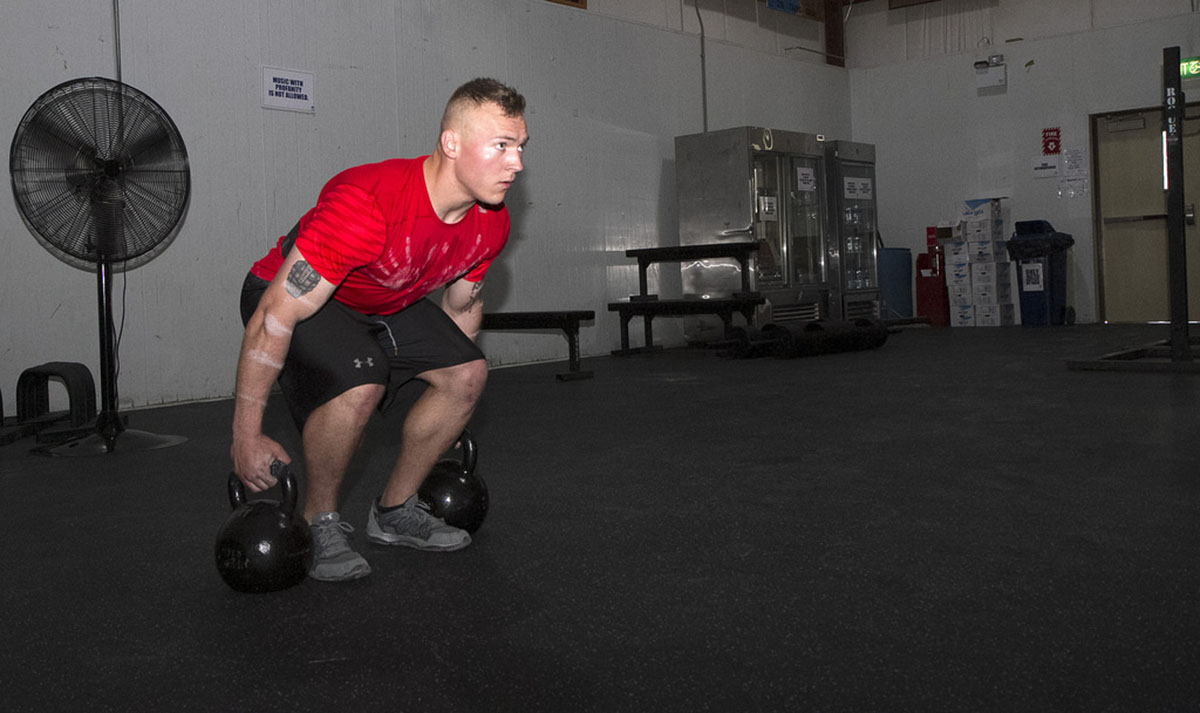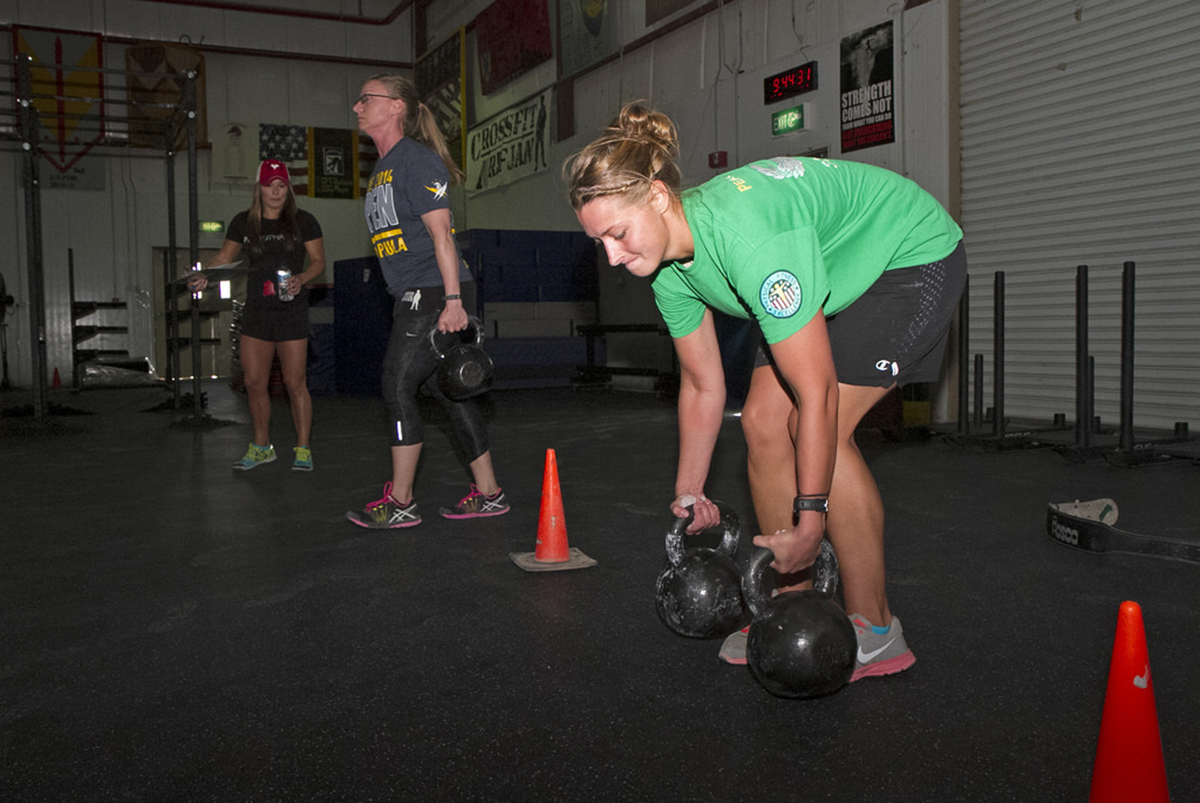The clean and jerk is a staple movement of Olympic weightlifting. In the Olympic clean and jerk, the athlete makes three attempts to lift a maximal load overhead in a two-part movement. Kettlebell clean and jerk is a very different animal, but the real basis of the movement is the same. It’s about the movement pattern that allows the most efficient transition of the load from the floor to overhead.

The barbell clean and jerk is a highly complex – not complicated, complex – movement, possibly the most technical and explosive athletic movement after the full barbell snatch. I’m just offering a quick overview here so I can differentiate it from the kettlebell equivalent. Barbell clean and jerk begins when the athlete performs a full clean, moving the bar from the floor to the bottom position of the front squat by catching the bar in the ‘racked’ position. Next, the athlete stands, and then ‘splits’ under the bar, pushing the bar up and dropping under it simultaneously to end with the bar overhead and one leg in front, the other behind, a position familiar from the overhead lunge many PTs use as a less technical substitute. Finally the athlete stands up fully, feet together, knees and elbows locked.
As you can see this is a lift you’d want some coaching in, especially in view of the kinds of weight that get moved this way!
However, it’s important to note that this isn’t a random selection of movements.
So the theory goes.
The proof of the pudding is in the eating: Oly lifters are some of the world’s strongest and most explosive athletes. Many coaches program O-lifts for their non-lifting athletes for that reason, though others point to the technical difficulty of the O-lifts and find alternatives that give the athlete more time for his or her sport.
So what’s the difference between the Oly clean and jerk and the kettlebell one?
Kettlebells are supposed to be submaximal. You’re not supposed to be going all-out in terms of load with each lift; you’re supposed to be going for power, strength and endurance all at once. It’s that combination of athletic traits trained simultaneously that makes kettlebells so appealing to a wide variety of athletes. Additionally, kettlebell lifts are almost always less technical than O-lifts.
What it has in common with the Oly clean and jerk is the basic pattern of movement, and the idea that this will be your strongest overhead lift. Expect to clean and jerk a heavier bell than you snatch with, or to manage more volume with the same bell.
See Also: No Time for the Gym? Use Kettlebells for a Full Body Workout
Let’s begin with an overview of the kettlebell clean and jerk
Start with the bell on the floor, and swing it. Remember, the secret is, the snatch is a swing; the clean is a swing; the basis of kettlebell movement is the swing. Shorten the arc of the swing to clean the bell to the chest and set; make sure you’re strong and firm. Now, drop a little, then drive upward with your legs. This is similar to a push press, but with more push. Finally, catch the bell overhead, as you resume a fully upright posture. There’s no real ‘press’ here, and if you find yourself pressing you’re cheating!
Putting It All Together: The Kettlebell Clean and Jerk in Detail
We’ll briefly talk about the clean, then look into the jerk in more depth.
The Clean
The clean is a swing. As you approach the fastest part of your swing in terms of the speed the bell is moving, start to pull the bell toward you, rotating your arm as you do so. Turn your thumb up and your elbow in and pull your shoulder back. The bell should begin to travel towards you and continue on its upward path too. When your clean is smooth, the bell should land in the racked position without any apparent force; there shouldn’t be a bump of any kind. The racked position should have a tall spine, rather than a ‘high chest,’ with the hips and neck in a neutral position. The pull you use to bring the bell in towards your body should be an extension of the pull you'd use in a swing anyway.

The Jerk
From the racked position, you’re going to put the bell overhead in two stages. The first stage is the drive, pushing the bell to about head height by straightening the lower body. The next stage is the dip, where you’ll drop the lower body, getting the body under the weight. Finally you’ll catch and extend.
1: The drive
Drive the bell overhead.
Practice without a load first. The bottom position of the drive is the rack. The top position is with the elbow down and slightly abducted, the forearm vertical and the thumb just above the top of your head. You get here by driving the body upward by extending the hips slightly, and standing up on the balls of the feet.
2: The dip
You’re going to drop under the bell and catch it with a straight arm.
That means bending the legs sharply, while keeping the back straight. In essence, you’re moving from extended legs and a bent arm to an extended arm and bent legs. The heels go back down firmly – try not to stamp, but begin driving through the heels as soon as they hit the ground. You’re in a quarter squat at this point; standing up fully erect completes the rep. Wrap your scapula and keep a solid core.
See Also: One-Armed Kettlebell Swings For Rotational Core Stability
If there’s something I haven’t explained, or you have your own skill or experience to share with us, why not get in touch through the comments section below?
- Photo courtesy of US Army Central by Flickr : www.flickr.com/photos/usarmycentral/13949933074
- Photo courtesy of US Army Central by Flickr : www.flickr.com/photos/usarmycentral/13926357411


Your thoughts on this